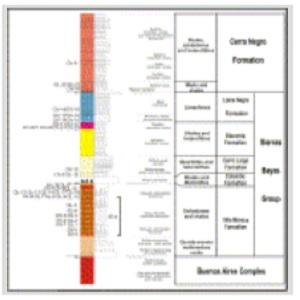Augusto E. Rapalini, Ricardo I. Trindade, Daniel G. Poiré
2 013
Precambrian Research Volume 224, January 2013, Pages 51-70
The Late Ediacaran to Cambrian Sierras Bayas Group (Villa Mónica, Cerro Largo, Olavarría and Loma Negra Formations) and the Cerro Negro Formation, exposed along the Tandilia system in the province of Buenos Aires (Argentina) were revisited and studied paleomagnetically. Our results supersede those of Valencio et al. (1980) for the La Tinta Formation (old stratigraphic name of these units). Three hundred and twenty-eight samples were collected from forty-four sites in gently folded to subhorizontal strata distributed along the whole stratigraphic succession. Detailed paleomagnetic study comprised systematic stepwise demagnetization by both AF and thermal methods, the latter being generally the most effective in isolating the characteristic remanence. Different magnetic components were defined from different units of the succession. Besides a recent, probably viscous, secondary component (component A), the most widespread magnetic remanence (component B) is a dual-polarity post-tectonic secondary remanence. This component, carried by both hematite and magnetite, corresponds to that originally determined by Valencio et al. (1980) and previously interpreted as primary. This component found in all carbonatic rocks of Villa Mónica and Loma Negra Formations as well as in several claystones and siltstones of the Olavarría Formation do not pass conglomerate and regional tilt tests. The mean in situ direction of component B is Dec: 359.8°, Inc: −63.3°, n: 85 samples, k: 24, α95: 3.2° and yields a paleomagnetic pole virtually identical to the previous one of Valencio and colleagues. It also matches those recently determined from secondary magnetizations in carbonatic and clastic Ediacaran units exposed in Uruguay. The pole positions suggest a Late Permian–Triassic age as the more likely for the acquisition of component B and reveal the presence of a widespread remagnetization event that affected very large areas of the Rio de la Plata craton. Despite this widespread event, some clastic units (claystones, marls) apparently escaped remagnetization. A pre-tectonic, dual polarity, mean remanence (Dec: 28.7°, Inc: 56.1°, n: 17 samples, k: 15, α95: 9.5°) was isolated from the latest Ediacaran–Early Cambrian Cerro Negro Formation (component C). In addition, the Ediacaran Olavarria Formation recorded another apparently ancient remanence, although no field test is available. Its direction (component D) is at Dec: 350.9°, Inc: 47.3°, n: 13 samples, k: 37, α95: 7.0°. Siltstones and claystones of the Ediacaran Cerro Largo Formation were carriers of a characteristic remanence (component E) that shows a better directional grouping after bedding correction, although the field test is not statistically significant, and yield a mean corrected direction at: Dec: 73.7°, Inc: −36.6°, n: 11 samples, k: 15, α95: 12.1°. Finally, a purple horizon of marls on top of the Villa Mónica Formation associated with weathering processes before deposition of the Colombo diamictite, was carrier of a characteristic remanence that attained a better grouping after bedding correction, but again with no statistical significance. This direction (component F) was at Dec: 43.4°, Inc: −36.3°, n: 7 samples, k: 45, α95: 9.1°. Components C–F are interpreted as ancient magnetizations associated either to post-depositional or early to late diagenesis. Mean geomagnetic poles computed from these components fall on the apparent polar wander path for the Rio de la Plata craton from around 600 to 520 Ma, in a correct stratigraphic order and with ages consistent with the most likely ages (or slightly younger) of the different sampled units. These results confirm the already proposed Ediacaran to Cambrian APWP for the Rio de la Plata craton, indicating that it remained at intermediate to low latitudes during most of the Ediacaran. Comparison with coeval paleomagnetic poles from other cratons indicate that by 575 Ma the Rio de la Plata and Congo-Sao Francisco cratons were likely a single plate. It also strongly argues against the generally accepted model that the Rio de la Plata craton was part of the conjugate margin of Eastern Laurentia during the final stages of Rodinia break-up at around 580 Ma.

